Naupa Iglesia: An Egyptian Portal in the Andes?
Halfway up a near-vertical ravine in the Andes, someone carved an inverted V-shaped entrance into the mountainside. Then they sliced the bedrock with great precision to create a shallow door that goes nowhere; the same design appears in ancient Persia and Egypt. Then for good measure, they carved an additional altar with three alcoves into an outcrop of bluestone.
What is the explanation for this sacred site named Naupa Iglesia, or more accurately, Naupa Huaca.
Windows into Paradise
It’s not by accident such 'doors' are referred to as spirit doors or windows into paradise: a naupa is an inhabitant of the spirit world, and as it happens, the false door of Naupa Iglesia marks the passage of the earth’s electromagnetic currents, the very forces that are known to generate out-of-body states.
It takes a hard heart to stand here and not feel the palpable energy of place. It is transfixing as much as it is bewitching. And perhaps that is the foremost reason why this site was carved in such a remote and inaccessible location in Peru.
The very nature of its location makes any astronomical relationship unlikely, so we are open to entertain the idea that this temple was used for a restricted shamanic ritual. Temples of a similar nature in other parts of the world typically require a difficult access, followed by a sensory deprived environment which generates conditions for the candidate to access other levels of reality.
- Lost Peruvian Huaca Pintada and its 1,000-Year-Old Mural Rediscovered
- Ritual Chambers of the Andes: Used in Secret, Near Death Simulations
Musical Measurements
The measurements of the main portal of Naupa Iglesia are not random, they conform to musical notation. The length to height ratio is 3:1, making a perfect fifth in the second octave; the ratio of the alcove is 5:6, a minor third.
The 5:6 ratio is both unusual and filled with specialist information. It perfectly describes the movement of the Earth, whose pole completes one full rotation of its axis every 25,920 years, while the plane of the equator tilts four degrees every 21,000 years — a ratio of 5:6. This accurate calculation of the motion of the planet is also encoded in another unusual temple, the Bent Pyramid of Egypt, whose slope angles encode the same ratio.

Bent pyramid of Sneferu, Dahshur, Egypt. (CC BY-SA 3.0)
Dominating the unique environment of Naupa Iglesia is the cave ceiling. It has been expertly sliced like butter (bear in mind we are at an altitude of 9800 feet (2987.04 m) on the side of a ravine) and smoothed with laser-like precision to create two different yet specific angles: 60 degrees and 52 degrees. There is only one other place on earth where these two numbers appear side by side: the slope angles of the two major pyramids at Giza
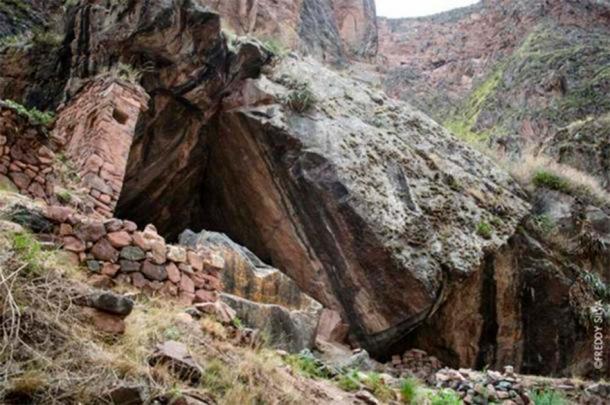
Stone angles on the sheer faces of ravine at Naupa Iglesia. Photograph © Freddy Silva
The violent earthquakes that regularly lay this region of the Andes have caused a fair share of damage at this site, preventing further exploration into this man-made cave. A later addition of a low wall made of stacked stone prevents rubble from a partially collapsed ceiling from falling onto curious and intrepid individuals who venture up the mountainside trail."
Still, there’s another anomaly to be examined in this temple: its creator picked the exact spot on the side of the mountain where a single outcrop of bluestone exists. Appearing in stark contrast with the surrounding sandstone, bluestone contains a type of crystal that was used in early radio receivers for its excellent piezoelectric qualities. The rock is also magnetic, another useful feature for shamanic journeying.
Bluestone was also specifically chosen to build the oldest part of Stonehenge, leading its architects to source this sonorous granite 150 miles (241.40 km) away in Wales. The site is believed to have been used for ceremonial purposes and spiritual rituals by the ancient inhabitants of the region. The presence of bluestone, known for its metaphysical properties, further emphasizes the spiritual significance of the site.
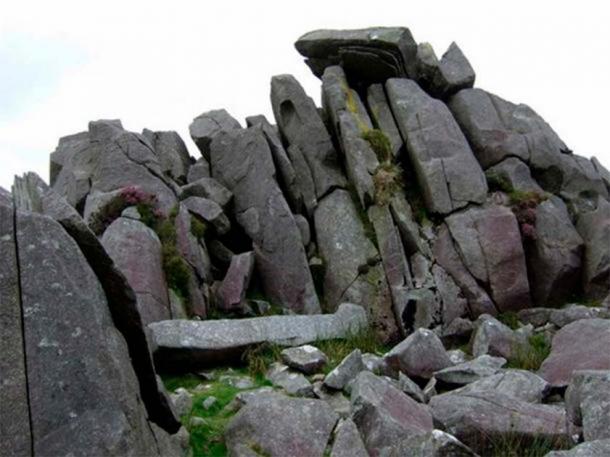
Stones at Carn Menyn, Wales, as an example of bluestone. These dolerite slabs, split by frost action, seem to be stacked, and ready for the taking. (Ceridwen/ CC BY-SA 2.0)
Sublime Enigma: The Secluded Depths of Naupa Iglesia’s Sacred Enclave
Naupa Iglesia stands as a testament to the profound knowledge and beliefs of the ancient civilizations that thrived in the Andes, leaving behind a mysterious legacy that continues to captivate researchers and visitors alike.
The outcrop has been expertly shaved into three niches, and although partly dynamited by religious fanatics, the delicate workmanship is still evident. Its central niche is similarly cut to musical notation, the ratio 3:2, a perfect fifth.
The site's placement in a near-vertical ravine, halfway up the mountainside, suggests a deliberate choice to create a secluded and sacred space. This raises questions about the purpose and significance of the site. Was it intentionally carved in such a challenging location to create a heightened sense of awe and reverence? Could it have served as a place for secluded rituals or spiritual experiences?
The remarkable precision and meticulous craftsmanship exhibited in the carvings and measurements at Naupa Iglesia further add to its enigmatic nature. The intricate details, aligned ratios, and musical notations incorporated into the design suggest a deep understanding of sacred geometry and cosmic principles. This attention to detail hints at the site's potential role as a gateway or portal connecting different realms of existence or facilitating spiritual journeys.
Naupa Iglesia continues to captivate researchers, archaeologists, and spiritual seekers, inviting them to unravel its mysteries and explore the profound wisdom encoded within its walls. As we delve deeper into the secrets of this ancient site, we uncover glimpses of a civilization that sought to bridge the earthly and the divine, leaving behind a testament to their profound spiritual beliefs and understanding of the universe.

Naupa Huaca. Photograph © Freddy Silva
The three-step design defines the Andean view of the Universe: the creative underworld, the physical middle world, and the ethereal otherworld. The concept is idealized in the chakana, commonly known as the Andean Cross. Chakana literally means 'to bridge or cross,' and it describes how the three levels of existence are connected to each other by a hollow reed — a culturally shared concept in ancient Persia, Egypt, the southwestern United States, and the Celtic world. The oldest iteration of the design is carved on a monolith at Tiwanaku, the world's oldest temple complex, and it differs from the later version in that it is based not a square but a rectangle with a ratio of 5:6.
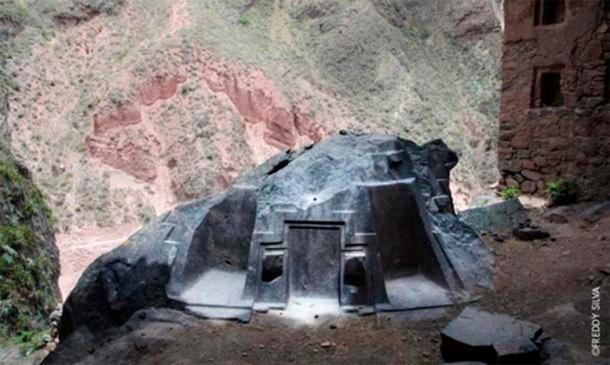
A carved altar with three alcoves into an outcrop of bluestone. Photograph © Freddy Silva
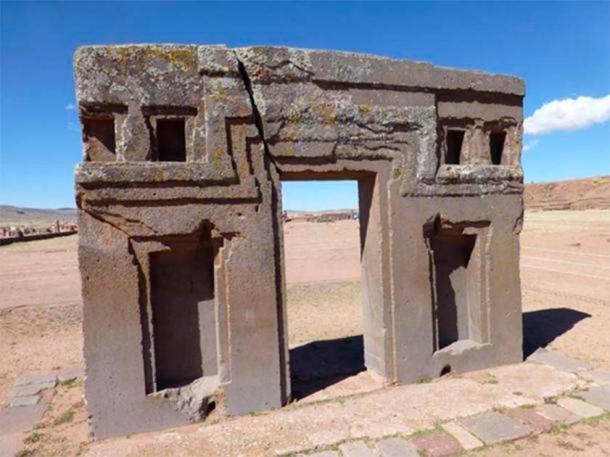
Ruins at Tiwanaku, Bolivia. (CC BY-NC-SA 2.0)
It seems that Naupa Iglesia was designed by a cosmic mason for anyone wishing to access another level of reality and communicate with gods which, back in the day, were either forces of nature, or elevated people who personified or understood how to control such forces.
Who Created Naupa Iglesia?
As to the identity of the architect, certainly the Inca can be dismissed. Inca stonework pales by comparison in both scale and quality, they merely inherited and maintained a culture that was, by their time in the 14th century, already long-vanished; even the ancient Aymara claimed such temples were made long before the Inca.
- Newgrange and Saqsayhuaman: Separated at Birth in 3050 BC?
- Banduddu: Solving the Mystery of the Babylonian Container
The style of stonework at Naupa Iglesia is consistent with that found in Cuzco, Ollantaytambo, and Puma Punku , and what these sites have in common is the myth of a traveling builder god named Viracocha who, together with seven Shining Ones, appeared at Tiwanaku after a catastrophic world flood, since dated to 9703 BC, to help rebuild humanity.
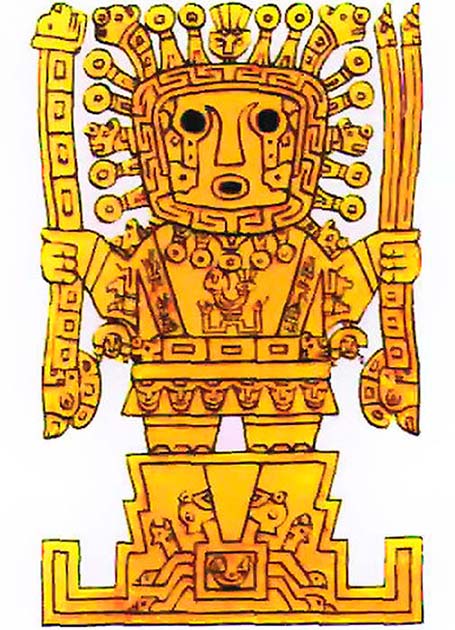
Viracocha. (Public Domain)
Interestingly, the same group appears at the same time in Egypt as the Aku Shemsu Hor — the Followers of Horus.
© FREDDY SILVA, 2016 | www.invisibletemple.com
Freddy Silva is a best-selling author, and a leading researcher of alternative history, ancient knowledge, sacred sites, and the interaction between temples and consciousness. He is author of many books, including THE LOST ART OF RESURRECTION
















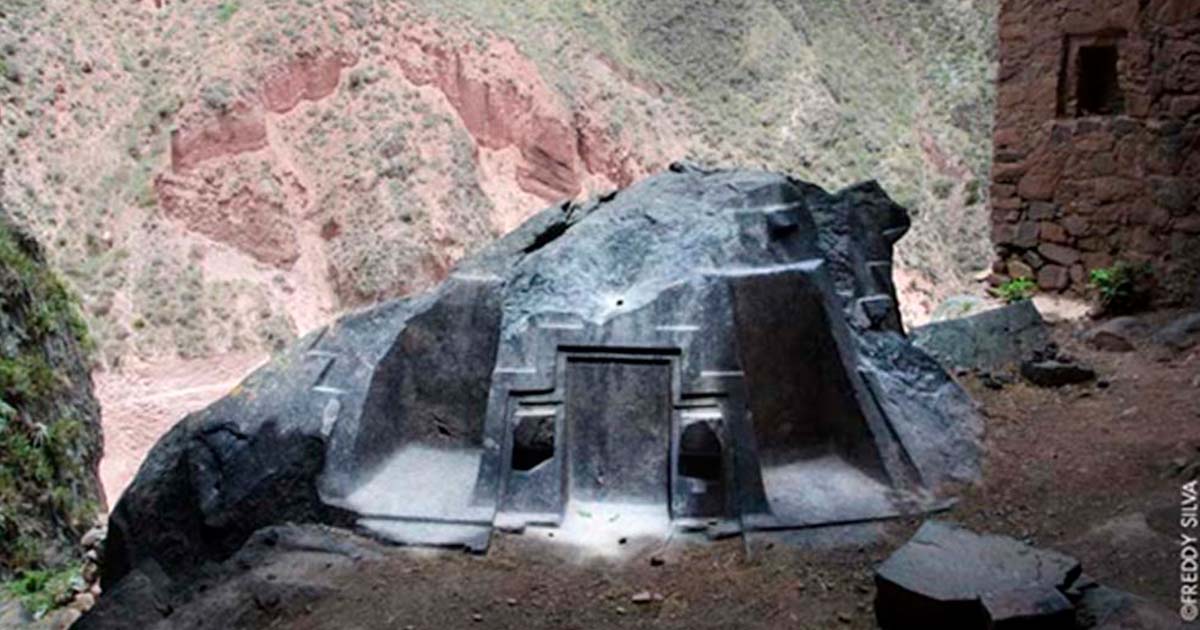
Comments
The normal angle of incline was ~52.5 degrees, a slope which would have resulted if the height was made to correspond with the radius of a circle, the circumference of which was equal to the perimeter of the pyramid at ground level.
I.E.S. Edwards, ‘The Pyramids of Egypt’ (1947)
Many ways to arrive at significant and interesting numbers ...
Am I the only one seeing the spacecraft?
Are we back in the 1960s here?. When I read about measurements, ratios and angles it takes me back to the 1960s where much was written about the data found in the pyramids of Egypt. It is like looking at clouds in the sky and seeing all types of animals. You can deduce anything you like from interpreted data.
The Spanish, who were Catholics, made it a habit to destroy anything that might end up contradicting the Catholic religion. Manuscripts, hieroglyphics, structures, whatever....they destroyed it. There's no telling what, or how many, valuable artifacts, were destroyed by the Spaniards.
History is nowhere near as well known as we think it is.
I took a group to Naupa Iglesia on 7 March '17. An interesting site that has, in my opinion, been deliberately destroyed. What we see being only a fraction of what he site once was. There are numerous holes bored into the rock that appear to be where some form of primitive explosive have been placed. On the picture above the rectangular carving is one, there are many others. Each seem to be where large sections of carved rock have gone. To the right there is a very large section that has completely gone, only the outer most caving remaining. There are large pieces of rock around what is left. The obvious question is who destroyed in and why? One can surmise it had to be the Spanish however their reason has to be the real question. I have a hypothesis that involves frequencies described in the articles text. Was this site so powerful the Spanish were scared of it?
Pages